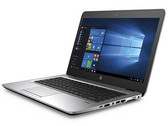
HP mt43 (A8-9600B, SSD, FHD) Thin Client Review
AMD PRO A8-9600B | AMD Radeon R5 (Bristol Ridge) | 14.00" | 1.5 kg

The AMD Radeon R5 (Bristol Ridge) is an integrated graphics card for a number of mid-range mobile Bristol-Ridge-based APUs, such as those from the A10 series. It features 384 shader cores clocked at 720 MHz (15 Watt APUs) or 800 MHz (35 Watt APUs). Depending on the configurable TDP (set per laptop model) and the used main memory, the performance can also differ.
The Radeon R5 utilizes the third generation GCN architecture (sometimes referred to as GCN 1.2) similar to the desktop Tonga chip. As a result, it supports DirectX 12 (FL 12_0) with advanced color compression that leads to a 5-7% improvement in games. Furthermore, its shaders can be used with Mantle, OpenGL and OpenCL. HSA 1.0 is supported for running code on both CPU and GPU cores simultaneously. The improved video decoder UVD 6 (Unified Video Decoder) is now able to decode HVEC / H.265 up to 4K in hardware. Furthermore, the VCE (Video Codec Engine) has been improved for faster transcoding of H.264. More information on architecture and features of the Bristol Ridge architecture can be found in our launch article.
Gaming performance of the integrated R5 GPU depends on the configured TDP, model and main memory of the system. A typical ULV version with a TDP of 15 Watt paired with fast dual channel main memory is nearly on a level with the dedicated GeForce 920M or Radeon R7 M260 (see gaming benchmarks below). Therefore, demanding games of 2015 and 2016 may only run in the lowest detail settings fluently (and some not at all).
Depending on the configured TDP, the still in 28 nm produced chip may be used in thin-and-light (12 - 20 Watt range) to standard-sized laptops (35 Watt TDP).
Radeon R (Stoney / Bristol Ridge) Series
| ||||||||||||||||
| Codename | Bristol Ridge | |||||||||||||||
| Architecture | GCN 1.2/2.0 | |||||||||||||||
| Pipelines | 384 - unified | |||||||||||||||
| Core Speed | 800 (Boost) MHz | |||||||||||||||
| Memory Bus Width | 64/128 Bit | |||||||||||||||
| Shared Memory | yes | |||||||||||||||
| API | DirectX 12 (FL 12_0), OpenGL 4.4 | |||||||||||||||
| Power Consumption | 12-45 Watt | |||||||||||||||
| Transistor Count | 3.1 Billion | |||||||||||||||
| technology | 28 nm | |||||||||||||||
| Features | UVD 6, VCE | |||||||||||||||
| Notebook Size | medium sized | |||||||||||||||
| Date of Announcement | 01.06.2016 | |||||||||||||||
| ||||||||||||||||||||
The following benchmarks stem from our benchmarks of review laptops. The performance depends on the used graphics memory, clock rate, processor, system settings, drivers, and operating systems. So the results don't have to be representative for all laptops with this GPU. For detailed information on the benchmark results, click on the fps number.









































































For more games that might be playable and a list of all games and graphics cards visit our Gaming List



HP 15-ba053ng: AMD A10-9600P, 15.60", 2 kg
External Review » HP 15-ba053ng
HP 15-ba048ng: AMD A10-9600P, 15.60", 2.1 kg
External Review » HP 15-ba048ng
HP Pavilion 15-aw004ng: AMD A10-9600P, 15.60"
External Review » HP Pavilion 15-aw004ng
» Comparison of GPUs
Detailed list of all laptop GPUs sorted by class and performance.
» Benchmark List
Sort and restrict laptop GPUs based on performance in synthetic benchmarks.
» Notebook Gaming List
Playable games for each graphics card and their average FPS results.
Top 10 Laptops
Multimedia, Budget Multimedia, Gaming, Budget Gaming, Lightweight Gaming, Business, Budget Office, Workstation, Subnotebooks, Ultrabooks, Chromebooks
under 300 USD/Euros, under 500 USD/Euros, 1,000 USD/Euros, for University Students, Best Displays
Top 10 Smartphones
Smartphones, Phablets, ≤6-inch, Camera Smartphones